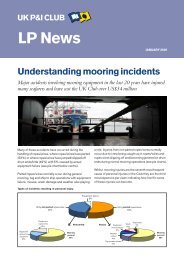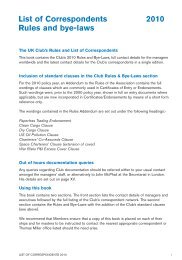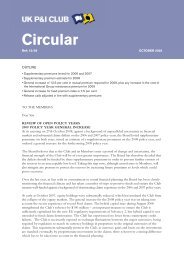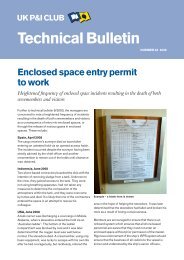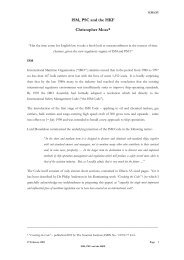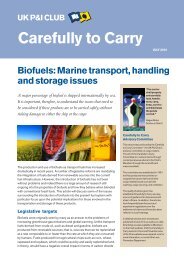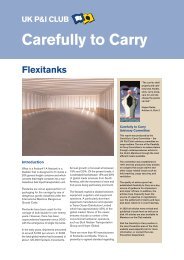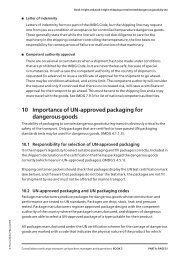Bulk Matters - UK P&I
Bulk Matters - UK P&I
Bulk Matters - UK P&I
Create successful ePaper yourself
Turn your PDF publications into a flip-book with our unique Google optimized e-Paper software.
Graph 1: Relationship of vapour pressure and relative humidity at<br />
different temperatures<br />
Vapour pressure mm mercury<br />
40<br />
35<br />
30<br />
25<br />
20<br />
15<br />
10<br />
5<br />
100%RH<br />
75%RH<br />
50%RH<br />
0<br />
-5 0 5 10 15 20 25 30 35<br />
Temperature 0 C<br />
and at 30°C of 32mm Hg – i.e. an increase of 20°C has<br />
resulted in a more than three-fold increase in the waterholding<br />
capacity of the atmosphere.<br />
Condensation<br />
If air is cooled to the point where saturation (100%<br />
relative humidity) is reached, then moisture will begin to<br />
be deposited in the form of droplets or mist i.e.<br />
condensation will occur.<br />
Ship’s sweat<br />
If the air in a ship’s hold is warm and it comes in contact<br />
with the deckhead which has become cooled by the<br />
outside atmosphere, so that the temperature of the air<br />
close to the surface of the deckhead may be reduced<br />
below that at which saturation vapour pressure for that<br />
particular water content is reached, i.e. 100% relative<br />
humidity, then condensation will normally form on the<br />
deckhead in the form of sweat.<br />
Equilibrium relative humidity (water activity)<br />
Equilibrium point<br />
All biological materials normally contain a certain<br />
amount of water. The amount of moisture present at any<br />
given time is the moisture content. If the material is put<br />
in contact with dry air, then it will tend to lose a small<br />
proportion of its water to the air in the form of water<br />
vapour. This process will continue until an ‘equilibrium’<br />
of the air in contact with the material of that particular<br />
moisture content and at that particular temperature.<br />
Equilibrium relative humidity is sometimes referred to as<br />
‘water activity’. The latter is measured as a ratio rather<br />
than as a percentage thus equilibrium relative humidity<br />
of 50% is equivalent to a water activity of 0.5.<br />
Usually, with a biological cargo, the condition of the<br />
atmosphere within the cargo (that is, of the air trapped<br />
between the various particles of the cargo) is controlled<br />
largely by the condition of the cargo. In cargoes such as<br />
bulk grain, where air movement within the bulk is very<br />
restricted, the moisture content of the atmosphere within<br />
the cargo (which is also termed the ‘interstitial’ or ‘inter<br />
particular’ air) is, under normal conditions, completely<br />
controlled by the temperature and moisture content of<br />
the cargo.<br />
Experimental work with maize has made it possible to<br />
construct graphs that equate equilibrium relative<br />
humidity with moisture content at various temperatures.<br />
Such graphs are known as ‘desorption isotherms’, since<br />
all the experiments were constructed so that to achieve<br />
equilibrium relative humidity, moisture was given up by<br />
the maize to the surrounding air. If the air around the<br />
maize is wetter than the equilibrium relative humidity,<br />
then the maize will absorb moisture from the air. Such a<br />
process is known as ‘adsorption’ and a similar series of<br />
curves or isotherms can be constructed which are called<br />
‘adsorption isotherms’. The relationship between<br />
adsorption and desorption isotherms is a complex one<br />
and it is not proposed to discuss it at length in this<br />
article. However, it may be stated that under conditions<br />
of desorption, the equilibrium relative humidity at any<br />
given moisture content is slightly lower than under<br />
conditions of adsorption. Normally in the grain trade,<br />
from harvesting through to the discharge of cargo, there<br />
is a tendency for the grain to lose moisture to the<br />
surrounding atmosphere, and thus behaviour patterns<br />
should be deduced by a study of desorption isotherms.<br />
If a situation occurs where the grain is absorbing<br />
moisture from the atmosphere, strictly speaking, the<br />
behaviour pattern should be deduced by a study of<br />
adsorption isotherms.<br />
Moisture migration<br />
The mechanism of moisture migration<br />
It is necessary to understand the definition referred to<br />
above in order to appreciate the process of moisture<br />
migration. We will illustrate the mechanism by which<br />
moisture migration operates by considering a cargo of<br />
bulk maize. With this commodity migration is slow.<br />
Change of temperature – change of ERH<br />
– change of vapour pressure<br />
We have already stated that the interstitial air that<br />
occupies some 40% of the cargo space in the case of<br />
maize in bulk will contain water vapour, and the vapour<br />
pressure in this air will rapidly reach equilibrium with the<br />
moisture content of the maize. In maize with a moisture<br />
content of 14% and a temperature of 25°C, the relative<br />
humidity of the interstitial air will rapidly reach 68% and<br />
the water vapour pressure in the air at that time will be<br />
14




